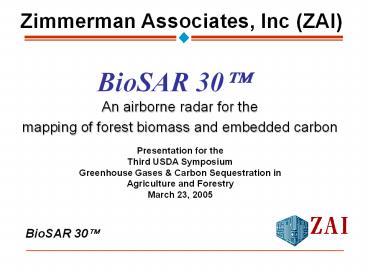An airborne radar for the - PowerPoint PPT Presentation
Title:
An airborne radar for the
Description:
BioSAR 30. An airborne radar for the. mapping of forest biomass and embedded carbon ... www.terresense.com. Marie Sparrow. 703-883-0506. msparrow_at_terresense. ... – PowerPoint PPT presentation
Number of Views:85
Avg rating:3.0/5.0
Title: An airborne radar for the
1
Zimmerman Associates, Inc (ZAI)
BioSAR 30?
An airborne radar for the mapping of forest
biomass and embedded carbon
Presentation for the Third USDA
Symposium Greenhouse Gases Carbon Sequestration
in Agriculture and Forestry March 23, 2005
2
Acknowledgements
- Dr. Marc Imhoff, NASA GSFC
- Dr. Roger Dahlman, DOE BER
- Mr. John Litynski, DOE FE
3
Overview
- Radar (RF) Remote Sensing of Biomass
- NASA Experiments
- DOE Refinements BioSAR 30TM
- February 2005 Mission
- Features, Advantages, Benefits
- Spin-Off Company Terresense
4
Radar Remote Sensing of Biomass
- Radar energy is reflected by leaves
- Radar receivers are saturated by
- these reflections
- Beyond saturation, measurement not possible
- Radar Biomass load limits at saturation
- X-Band (10 GHz ? ? 1) 10 tons/ha
- P-Band (500 MHz - ? ? 2) 100 tons/ha
5
Location of World Biomass
- 90 of world biomass resides in stands of over
100 tons/ha - For Radar remote sensing of 90 of world biomass
need VHF frequency - 100 MHz, ? ? 10
6
Basic BioSAR 30? Technology
- Airborne Small Synthetic Aperture Radar (SAR)
- Operates at 80-120 MHz, ? 10
- Low power lt 1 watts
- Data collected at 166 KHz
- Data tagged with dGPS time and location
- Radar footprint is a 600 mt circle (80 acres)
- Processed cell size 30 x 300 meters (1 acre)
7
NASA C-130 In Flight
BioSAR 30TM antenna
8
Smithsonian Tropical Research Institute Test
Sites Biomass 200 to 300 tons/ha (above-ground,
dry, biomass).
- Site Latitude Longitude Biomass
(tons/ha) - 1 9.160127 79.859973 207.4
- 2 8.987363 79.617125 212.2
- 3 8.996870 79.642082 212.3
- 4 9.121305 79.672340 218.8
- 5 9.140858 79.692410 235.1
- 6 9.152628 79.713770 235.9
- 7 9.143868 79.857983 243.9
- 8 9.157593 79.750405 252.2
- 9 9.280008 79.974252 258.8
- 10 9.322290 79.960888 259.3
- 11 8.986632 79.637610 288.9
9
BioSAR Estimated Biomass vs.Ground Truth
(total above-ground dry biomass)
320
10 of Total
300
280
260
Estimated Biomass, tons/hectare
240
220
200
180
200
210
220
230
240
250
260
270
280
290
Ground Truth Biomass, tons/hectare
10
BioSAR-Generated Biomass Mapof the Panama Canal
Zone, Panama
11
DOE Refinements - BioSAR 30TM
- DOE Grants
- Improved processing algorithms
- Improved data storage and archiving
- Addition of Laser Radar
- Addition of external calibration device
12
BioSAR 30TM Installed in Twin Otter Aircraft
13
BioSAR 30TM Operators Station
14
BioSAR 30TM Antenna
15
DOE Mission to North Carolina
- February 17,18 2005
- 30 Sites selected Each Site 100 acres
- Collaboration with Weyerhaeuser Corp.
- GPS waypoints for each site computed
- North-South, East-West Leg for each site
- All sites flown in one day, repeated next day
16
Aerial Photograph of Site 19
17
BioSAR 30TM Flight Lines - Site 19
18
Data Points and Biomass for Site 19
19
Video View of Site 19
20
Observations vs. Ground Truth
Site 19
Feb 17 Feb 18 N-S E-W
N-S E-W
2003 Ground Truth 160 tons/ha
21
30 Square Mile Survey - 1 Day
22
Features, Advantages, Benefits
Feature Advantage Benefit
Time Required Coverage Cost Platform Accuracy Remote vs. manual 100 vs. 1 survey 2 vs. 10 per acre Aircraft vs. vehicle Measurement vs. approximation Hours vs. weeks Reproducibility Reduced costs Accessibility Better Results
23
- New Company
- Spin-Off from ZAI
- Offering commercial BioSAR 30? services
- 2.00/acre (Minimum 50K) ferry charges
- 30 sq. miles/day ( 19K acres, 7.8K ha)
- Product will be GIS/GPS Overlays Biomass/Carbon
- Brochures and details available
- Taking orders now
- www.terresense.com
24
Points of Contact
- ZAI www.zai-inc.com
- Patrick W. Johnson
- 301-371-3584
- pjohnson_at_zai-inc.com
- Terresense www.terresense.com
- Marie Sparrow
- 703-883-0506
- msparrow_at_terresense.com































